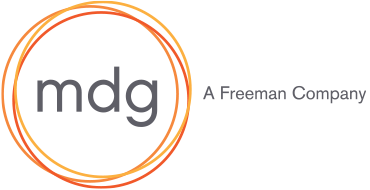
We often talk about the power of storytelling and making emotional connections with our audiences. One event marketing approach that maximizes the power of both of these is using testimonials. While testimonials have been a stalwart of the event marketing community for years, today—in the age of social media and review sites like Yelp—more credence is given to the opinions of others during the decision-making cycle than ever before. As an account strategist and executive director of mdg’s Chicago office, I lead testimonial campaigns utilizing three guiding principles:
1. Be authentic. Use attendees’ own words as much as possible. Rehearsed, pre-written and polished soundbites are for politicians (well, they used to be). People believe, and therefore value, conversational verbiage and casual speak.
This means moving away from formulated quotes that perfectly capture your value proposition and moving toward genuine reactions to your event. Some of our favorite testimonial quotes over the years have been things like, “This is my favorite time of year!” and “My friends say I’m crazy, but I like coming here better than I like going on vacation.” These quotes perfectly capture the genuine enthusiasm and affinity that attendees have for events—even though they don’t call out specific features and benefits. The power comes from authentic passion.
Pro Tip: These types of spontaneous emotional quotes are often found on social channels.
2. Get specific. Often, testimonial campaigns rely on generic platitudes like, “Everyone who is anyone is here” or “This show is a one-stop shop for everything I need to run my business.” If you are getting quotes like this from your participants, dig deeper by asking follow-up questions. For instance:
- What specifically did you find on the show floor and how do you anticipate it will impact your business?
- What takeaways did you get from the education sessions and how will you apply them?
- What business/professional challenges are you solving by being at this event?
Individually, these stories are highly relatable to likeminded audience segments; in aggregate, they speak to the power of your event overall. If testimonial quotes are the basis of your campaign, target your non-participating prospective attendees with quotes from their peers talking specifically about what they found and what they learned at the most recent show.
Pro Tip: Create FOMO by reminding non-attendees what they miss when they don’t attend.
3. Prioritize video. It’s virtually impossible to proclaim, “This is my favorite time of year!” without radiating enthusiasm. Since passion, delight and energy just don’t come through in writing the way they do on camera, video should be your primary testimonial vehicle. And true, not all attendees or exhibitors are great on camera, but that can be a good thing (see: Be authentic, above). This is where a great video crew and producer are critical—the right team can identify the attendees and exhibitors that are truly enjoying themselves, who are excited by what they are seeing and who are genuinely happy to be there. And they can make them comfortable, coaching them for the camera.
Pro Tip: You’re enhancing the tendency of enthusiastic attendees to evangelize your event in their daily lives by involving them in your efforts and campaigns.
Even if you aren’t using testimonials in your campaign, it’s still critical to have enthusiastic third-party validation of your event in a world where up to 92 percent of people read online reviews and testimonials as they consider a purchase. Today, it’s about proactive marketing efforts; tomorrow, event marketers may be contending with a “Yelp for Events” site. Either way, the ability to effectively curate and promote customer enthusiasm is essential.
Want more happy attendees gushing about your event? Contact Kimberly Hardcastle today to grow attendance at your next show.


